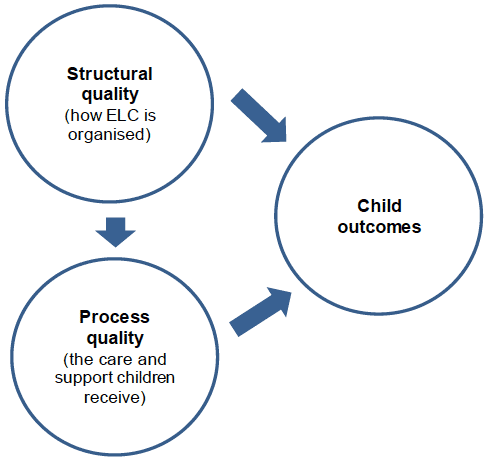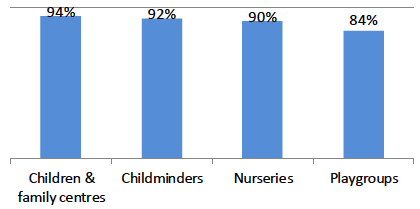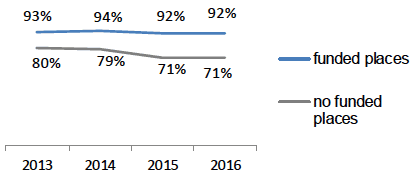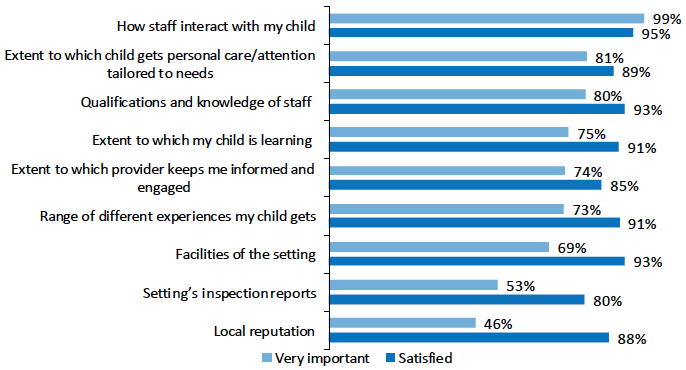The expansion of early learning and childcare: evaluation report 2017
A report exploring the impact of the expansion of government-funded early learning and childcare after 2014.
This document is part of a collection
6. Quality
Key findings
- Overall, quality of funded ELC provision in Scotland is rated highly, and has remained broadly stable over the past 4 years, since before and after the expansion following the 2014 Act. In 2016, 92% of providers of funded ELC were graded good or better on all Care Inspectorate quality themes, compared to 93% in 2013.
- ELC providers providing the funded entitlement on average receive higher quality ratings than those not providing funded entitlement, of whom 71% were graded good or better on all quality themes in 2016. This followed a drop from 79% to 71% between 2014 and 2015 for providers not offering funded entitlement. More analysis would be needed to better understand te causes of this drop.
- There are no significant differences in the overall quality ratings of ELC providers between urban and rural areas, or different SIMD areas.
- The large majority of parents are satisfied with the quality of their main current provider of funded ELC.
One of the primary aims of the ELC expansion is to support children's development, especially children from the least advantaged backgrounds. For this it is crucial that the available ELC is high quality, as evidence suggests that higher quality ELC will contribute to better social, emotional and cognitive development. For example, analysis with data from the Growing Up in Scotland study on Scottish children born in 2004/05 and 2010/11, linked aspects of the quality of ELC provision to vocabulary development, [34] pro-social behaviour and fewer peer problems. [35] Likewise, a recently published broader evidence review on the quality of ELC by NHS Health Scotland highlighted the positive impact of high quality ELC on children's outcomes, especially on the most disadvantaged children. [36]
This chapter provides evidence on the quality of ELC provision in Scotland and changes between 2013 and 2016, as well as parents' satisfaction with the quality of ELC and their views on what is important for high-quality ELC. As such the chapter aims to explore any changes in quality after the expansion to 600 hours in 2014, provide baseline measurements for monitoring any changes as the expansion to 1140 is rolled out, and help inform the expansion.
Aspects of high-quality early learning and childcare
A distinction can be made between structural and process aspects of quality. [37] Process quality refers to the actual experiences in ELC settings, such as children's interaction with caregivers and their day to day activities. Structural quality refers to how ELC delivery is organised, such as leadership, the number and qualifications of staff, physical space and regulations. These structural aspects create the conditions for high quality care and support.

The Care Inspectorate assesses both aspects of quality in its inspections of all childcare providers, with grades given on the basis of four quality themes: care & support, environment, staffing, and management & leadership. [38] Below are the latest inspection figures, which were published in September 2017 and refer to the quality of childcare services as at 31 December 2016. [39]
Overall quality of childcare provision
Overall, the quality of childcare providers in Scotland is rated highly. The large majority of early years services received grades 'good' or better on all four quality themes assessed in 2016. There are some small differences between types of providers, with 94% of children and family centres graded good or better, compared to 92% of childminders, 90% of nurseries and 84% of playgroups, as shown in figure 18:
Figure 18: percentage of early learning and childcare providers graded good or better on all Care Inspectorate quality themes by type of provider

A similar pattern is seen when looking only at services providing the funded entitlement, with high quality grades overall, but children & family centres and nurseries on average receiving slightly higher grades than playgroups (childminding services providing funded places are not currently included in the data).
Quality of funded and unfunded early learning and childcare provision
On average, childcare services providing funded ELC places are graded higher than those not providing funded places. For example, figure 19 below shows that in 2016 amongst services providing funded places 92% received all grades of good or better compared to 71% of those not providing funded places.
For providers that offer funded ELC places quality ratings have remained broadly the same over the past years, but for providers not offering funded places the percentage graded good or better on all quality themes dropped between 2014 and 2015, from 79% to 71%:
Figure 19: percentage of ELC providers graded good or better on all care Inspectorate quality themes by whether they offer funded places

It could be that the drop between 2014 and 2015 in average quality of ELC providers not offering funded places is related to the funded ELC expansion in 2014. For example, this might have led to local authorities starting partnerships with different partner providers, or to some movement of ELC staff in the private or voluntary sector to partner provider settings. However, there were also changes in the wording used on the Care Inspectorate's annual return after 2014, so more analysis is needed to understand what contributed to the drop in average quality ratings of providers not offering funded places between 2014 and 2015.
Quality of nurseries
- Local authority nurseries in 2016 on average performed better than other nursery sectors, with 94% graded good or better on all four quality themes (care & support, environment, staffing, and management & leadership) compared to 82% of private and 88% of voluntary/not for profit nurseries.
- Yet the proportion of high-quality local authority nurseries did decrease slightly between 2015 and 2016, while the proportion of high-quality private and voluntary/not for profit nurseries increased slightly.
- Looking specifically at nurseries providing funded places, [40] in 2016, 94% of local authority nurseries providing funded places were graded good or better on all four quality grades, compared to 86% of private and 91% of voluntary/not for profit nurseries.
Quality differences
- There are no significant differences in quality between childcare services in rural and urban areas, neither when looking at all childcare services, nor when looking only at providers of the funded ELC entitlement.
- Likewise, there is no clear link between the quality of services and levels of deprivation across all childcare services or services providing funded places.
- Yet when looking only at childminders, on average, childminders in less deprived areas receive higher quality grades than those in more deprived areas.
Parents' views on quality of funded early learning and childcare
In addition to the importance of quality for children's development, parents' confidence in the quality of funded ELC provision is also important because it may influence their decision on whether and for how many hours to use the funded ELC entitlement.
In the 2017 ELC parent survey, parents were asked how (un)important they found different elements when judging whether a provider is delivering high quality ELC, and how satisfied they were with their current main provider of funded ELC. As can be seen in figure 20 below, a large majority of parents are satisfied with all aspects mentioned. The way staff interact with their child was the quality aspect considered very important by the highest proportion of parents, and also the aspect with which the highest proportion of parents were satisfied:
Figure 20: percentage of eligible parents saying aspects are very important when judging whether a provider is delivering high quality ELC, and percentage of eligible parents satisfied with those quality aspects in their main government funded ELC provider (2017 ELC Parent Survey)

Differences in what parents consider important when judging quality
Different groups of parents find broadly the same aspects important when judging the quality of ELC when thinking of parents in different income groups, age categories, deprivation areas, urban/rural areas, or with English as an additional language. However, there are notable differences in what parents with children with an additional support need ( ASN) consider important when judging the quality of an ELC setting.
- Proportionally more parents of children with ASN find the extent to which their child gets personal care and attention tailored to their needs very important (86% compared to 80% of all parents).
- For almost all the other aspects mentioned, proportionally fewer parents with children with ASN consider it very important for judging quality, with the most notable differences being the setting's inspection reports (found very important by 39% of parents of children with ASN compared to 53% of all parents), the facilities of the setting ( 55% compared to 69% of all parents), and the qualifications of staff ( 71% compared to 81% of all parents).
Differences in parents' satisfaction with quality
There are few significant differences in parents' satisfaction with the quality of different aspects of ELC amongst different groups of parents in terms of age, deprivation areas, urban/rural areas, and English as an additional language. The only statistically significant difference is that proportionately fewer parents with a household income of £60,000 or over are satisfied with the extent to which their main ELC provider keeps them informed and engages them in their child's learning than those with a household income of less than £16,000: 83% compared to 90%.
Yet on almost all aspects of quality mentioned, somewhat fewer parents with a child with additional support needs are satisfied than parents whose children do not have an ASN. The differences are statistically significant, and largest for:
- The extent to which their child gets personal care and attention tailored to their needs: 80% compared to 89% of all parents.
- The setting's inspection reports: 73% compared to 80% of all parents.
- Local reputation: 82% compared to 88% of all parents.
Contact
There is a problem
Thanks for your feedback